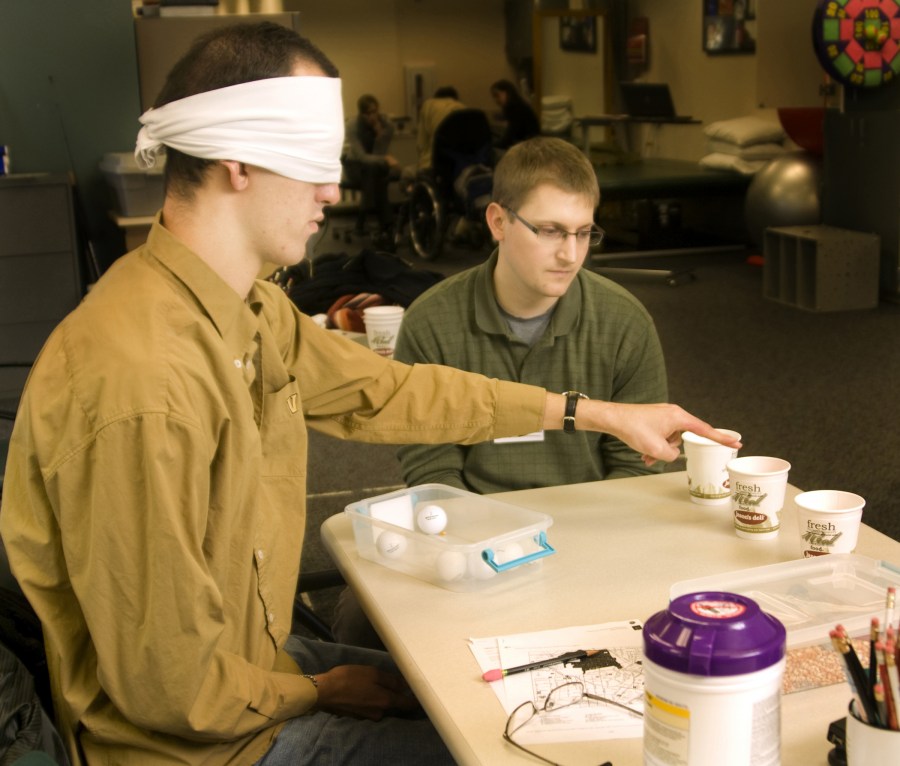
Vanderbilt law student Ted Spangler is making a strong recovery after suffering a serious stroke. (photo by Susan Urmy)
Stroke gave law student new take on ‘final exams’
Ted Spangler was prepared for his first final exam as a Vanderbilt University law student. He knew the material by heart and had packed plenty of snacks for the four-hour test.
What the 22-year-old hadn't prepared for was the 1.5-inch long, pencil-width blood clot that snaked its way to his carotid artery during the exam, blocking off all blood flow to the right hemisphere of his brain and causing a massive stroke.
“I finished the multiple-choice and got up to go to the bathroom. I felt really light-headed and weak on the left side, but I didn't think anything of it because when I'm dehydrated, I get light-headed. I figured I had been sitting in that exam for two hours and just needed to get something to drink,” Spangler recalled.
What happened in the bathroom is hazy, but Spangler remembers a fellow law student telling him to sit down before going to get help.

Vanderbilt Law student Ted Spangler, center, with members of the team that treated him following his stroke; J.J. (Buddy) Connors, M.D., left, and Paul Clemmons, R.N. (photo by Susan Urmy)
He was taken by EMS to the Vanderbilt University Hospital Emergency Department, where the neurology team, led by Derek Riebau, M.D., noticed the signs of a large stroke in progress. A rapid series of CT scans revealed an extensive blood clot in the right internal carotid artery — the main blood vessel that supplies the right side of the brain.
Spangler presented within the time window for intravenous tPA (tissue plasminogen activator), a clot-busting drug and the current standard of care for acute stroke.
“He did receive the medication per protocol, but given the size and extent of the blood clot, I felt there was a low chance that IV tPA alone would significantly dissolve it and re-establish blood flow,” Riebau said. “At that point, I felt his best chance was interventional therapy.”
What Riebau proposed was an endovascular neuro-interventional procedure, a process of actively removing the clot using clot retrievers, stents or suction devices, similar to procedures done for a heart attack.
Just the day before Spangler's stroke, J.J. (Buddy) Connors, M.D., had been running a weeklong seminar in Dallas to teach other physicians these therapies, and Riebau contacted him urgently. Connors literally wrote the book on endovascular stroke therapy. His text “Interventional Neuroradiology: Strategies and Practical Techniques” (Saunders/Elsevier, 1999) was the first to outline these interventional techniques.
Despite the promise of quickly restoring blood flow, neuro-interventional stroke therapy is not yet widely accepted in the neurological community.

Here, Spangler performs fine motor coordination exercises with Pi Beta Phi’s Collen Bonfiglio. (photo by Susan Urmy)
An intravenous drip of tPA has been proven safe and effective, but for certain severe strokes with large clots, endovascular procedures may be more effective. For large clots such as Spangler's, Connors believes in taking an active approach, knowing that the faster blood flow is restored the less likely the outcome will be death or permanent paralysis.
“I was speaking heresy, saying that IV tPA doesn't work well for large clots in large vessels since it cannot dissolve a big clot fast enough,” Connors said.
“It's kind of like having a clogged commode and putting drain cleaner down your kitchen sink. It isn't going to get to your commode. And even if you put it right down the commode, it may sit there for a week. What you need with a clogged commode is a plunger.”
In Spangler's case, that plunger was a suction device run through blood vessels from the groin to the clot in the brain.
“This is not yet considered standard of care. There are a lot of people around the country who still are not convinced of this approach, but in this particular instance, with just IV tPA, the chance of a good recovery would have been slim,” Connors said.
Even with the clot removed, Spangler was not out of danger yet. Like the knot that appears after a bump on the head, the care team was anticipating that his brain would swell in reaction to the trauma it had been through, and indeed it did.
Spangler was aggressively treated with medications to attempt to reduce the swelling, and was very close to having a section of skull removed to alleviate the pressure, but he never reached that tipping point.
Just a few days later, Connors was flabbergasted to see Spangler walking up and down stairs with a physical therapist.

Spangler is currently rehabilitating and plans to return to school in the fall. (photo by Susan Urmy)
“He had a large enough blockage of a major vessel that the recovery rate just for going home in a wheelchair is probably 10 percent,” Connors said. “I was praying that he was going to have enough strength in his leg to be able to walk. If he could walk, then I knew that he still had a right hand and could probably get through life. I never dreamed his left arm would return to normal, as has much of everything else.”
Every day since the stroke has been an improvement for Spangler. His smile gradually straightened in the hospital and he built enough strength to shower and shave on his own. Now with the help of Pi Beta Phi Rehabilitation Institute, he is working his way back to his pre-stroke self.
“We figure out what my deficits are and make up coping mechanisms,” Spangler said. “I practice every day, and I'm getting better every day. It's called neuroplasticity. There are dead parts in my brain, but I have a young brain so it is making new pathways around the dead parts.”
To a casual observer, Spangler looks perfectly normal. The one deficit that still eludes him is typing, and he would probably be at law school this semester if it weren't for that.
“I went back for a few days just to see if I could do it when I was only one month out from the stroke. I understood everything, I just couldn't type. It is hard to spread my fingers out. We do everything on computer, and I just couldn't keep up.”
Spangler is taking a medical leave of absence this semester and will return to law school in the fall.
“It was the best decision. The idea is to focus on getting better, then come back 100 percent.”
An extensive workup by the Neurology team revealed that Spangler's blood clot was caused by a genetic condition called homocysteinuria, in which the body is unable to process proteins properly and forms clots too readily.
Spangler is taking Vitamin B and blood thinners to prevent a future stroke. His younger sister also tested positive for the condition and is taking medication to prevent a similar stroke. Spangler jokes about “taking one for the team.”
Riebau said not every stroke patient is a candidate for interventional procedures, but Spangler was the perfect case.
“We saw that a large portion of his brain affected by the blood clot was still alive, but the brain can only live for a very short amount of time without adequate blood flow before it is permanently damaged.
"He is one of relatively few who present to the emergency room shortly after symptom onset, have brain tissue that is ischemic but not yet dead, and are fortunate to be at an institution with readily available neurology, neuro-interventonal and ICU teams experienced in acute stroke care,” he said.
Connors attributes the amazing outcome to the quick reaction to the situation and speedy removal of the clot.
“This is about the fastest save I've ever had in my career,” he said. “Dr. Riebau and the ER team hustled him through the ED and into CT very quickly, and from the time he fell down to the time he had complete blood flowing to his brain was on the order of four hours.
“If he had not presented to the ED as quickly as he did, or if his stroke had not been recognized and acted upon immediately, he might not be around right now,” Connors said













